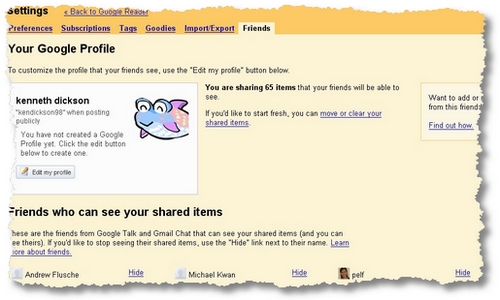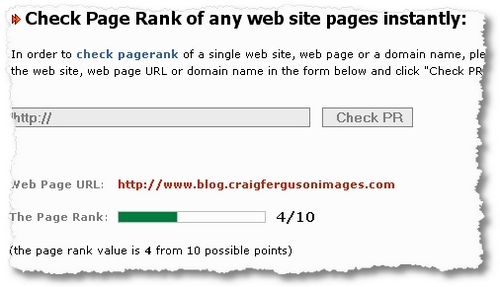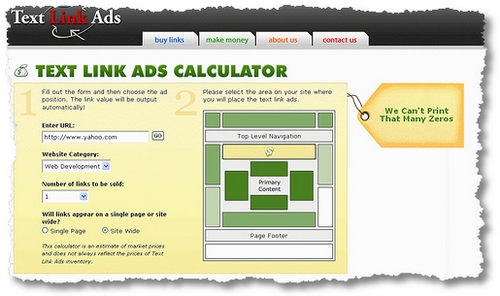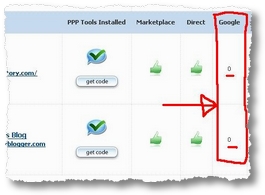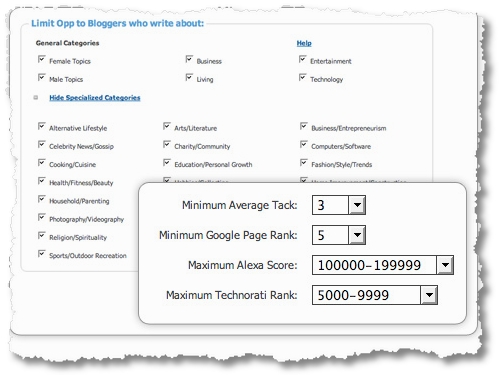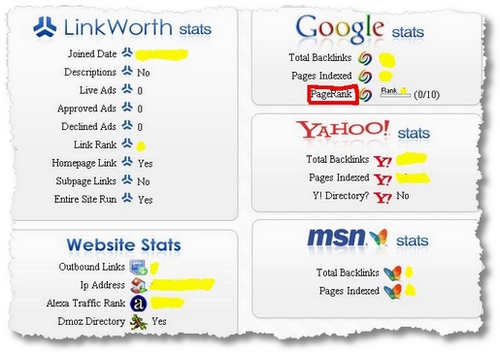As advertisers, bloggers and readers have struggled for quite some time to find quality blogs, ranking systems have come to the forefront as a shorthand for everyone. While the jury is still locked on whether ranking systems are accurate or not, having a metric is important particularly for advertisers as a way to judge the value of a website or blog, and the price of advertising.
Over the last few weeks, I’ve been examining the different ranking systems available to Bloggers and their Audiences including:
and also…
How I first signed up
When I first joined Payperpost, I was unaware of the importance of Technorati. It was only when in the summer of 2007 that Payperpost introduced (then subsequently removed) Technorati rankings as a way to evaluate a blog’s popularity that I actually had my blog added to their system. Since then, my blog’s linking popularity has soared from multiple millions to approximately 39,000 right now.
So what is Technorati?
Technorati is a search engine system that collates, indexes and makes searchable the approximately 112 million blogs in its catalogue. It was founded by Dave Sifry and its headquarters are in San Francisco, California, USA. (source: WikiPedia Entry).
Technorat’s whole modus vivendi is to search and index, then make the results easily found by visitors to the website. In this way it functions much like Google or Yahoo! BUT the focus is primarily on blogs, and so many traditional websites aren’t included UNLESS there is a blog on the website. Hence, many websites are now converting to blogs or CMS-type blogs for fronting their online operations: the whole blog type setup allows many ways for visitors to find blogs rather than in the 90’s type websites when sites were static and had to be found in directories.
Its business model is to then sell adverts in various guises around the content that is collated, indexed and presented to its users. It, in many respects, could be considered a ‘splog’ except for its size, and its additional ranking and interactive functions.
â€â€Ã¢â‚¬â€-
For more articles on running a business, making money, cutting debt, or creating your blog, subscribe to the RSS feed or email newsletter. There’s a lot more in the Random Walk to Wealth on InvestorBlogger dot com. Subscribe TODAY!
â€â€Ã¢â‚¬â€-
And why should I bother?
For bloggers, there are three specific reasons to bother registering your blog with Technorati: Traffic, Exposure, and Authority.
1. Traffic – you will get traffic from Technorati, traffic that comes to both your front page and your indexed posts, even posts that have been indexed for a while. During the past year of 2007, Technorati sent me approximately 2.8% of my total visits for the past 12 months, not great but all the 2.8%s add up, and it was in fact my #6 source of referrals;
2. Exposure – Both readers and advertisers will be able to evaluate (albeit crudely) the apparent ‘worth’ of your blog by its relationship to others. For readers, this means that they will either ‘discover’ an unranked or low ranked gem and enjoy the thrill or feel glad to be able to participate in a well-recognized niche blog with a decent ranking. For advertisers, this simply means traffic and potential traffic by advertising on better known sites in their niches, advertisers will be able to understand, value and purchase appropriate advertising because the metrics Technorati uses will help to sort the wheat from the chaff; and
3. Authority – Increasingly, websites and blogs are being perceived not for the volume of links to them, but for their apparent authority. The adoption of the term ‘authority’ by Technorati last year was an attempt to value the content of blogs by counting specific types of links and sites linking to a particular site. Google’s PageRank also attempts this method.
The downside? There is one, isn’t there?
As with all metrics there are shortfalls and problems inherent in the nature of the system. Technorati has numerous problems that indicate how to game their system. It’s not the nature of this posting to describe those methods in detail. They do exist, and as John Chow found out, you can get banned, too.
More importantly, though, the links themselves do NOT measure traffic to the blog well at all. In all respects, the links can be considered dead as they represent a potential path for traffic. In fact, Technorati expires links after a set period (usually six months). And the volume of links is not directly related to the amount of traffic. As such, if you see blogs that are moderately well linked, you may still have no idea how much daily traffic they have.
Some advertising companies DO rely on Technorati Rankings still as a way to evaluate the worth, either as a sole metric, or as part of a continuum of metrics, including REVIEWME, Text-Link-Ads, Payperpost (no longer), and more.
While bloggers (myself included) do rail against specific metrics from time to time, it’s difficult to deny that a triangulation of metrics, such as Alexa, PageRank and Technorati, may indicate that a blog is materially more popular than a similar blog in the same niche. Please note: I did NOT use the word ‘better’.
Lastly, there are technical problems with the website, with claims, and so on. I had a frustrating few months trying to claim a blog last year, until I actually blogged it. Weirdly, the problem was resolved quickly after that. Other bloggers reported the same thing at the time.
How to set up your blog on Technorati – in a few minutes
When you first sign up for Technorati and login, you can add your blog to their index in a simple fashion. Enter your blog URL in the ‘add URL’ on your account page.
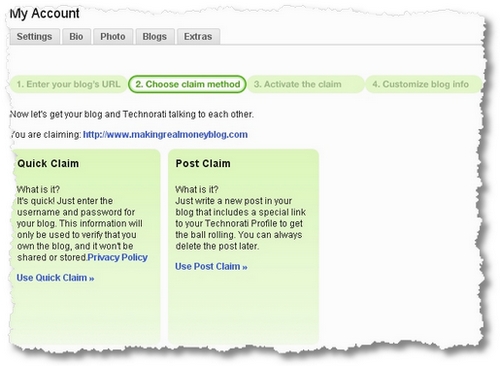
Claim That BLOG! It really is Mine!
Once entered, you need to ‘claim’ your blog and there are two simple ways: logging in via their website or posting a post on your blog with a special link that Technorati will pick. I’m choosing the first method as it’s much quicker, convenient, and doesn’t involve posting a useless item on your blog, an important thing to remember when you already have readers and subscribers!
So here goes…
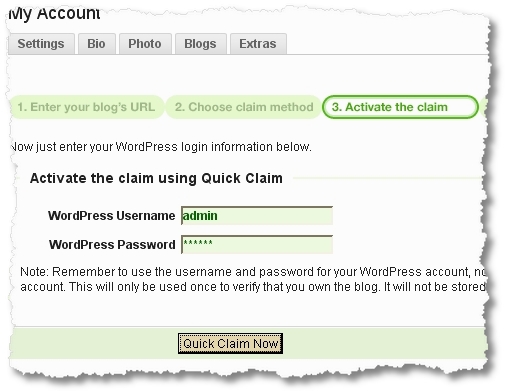
Now my blog has been claimed, and I need to add information to the entry, as below. If you’re not sure what to add, don’t worry as you can come back and change it later.

After the blog is claimed, you’ll see the entry listed in your account with buttons and information.

The buttons on the left are self-explanatory:
1. ‘Edit Settings’ takes you right back to the ‘settings page’, as you saw already.
2. ‘Edit widget’ takes you to a page with the widgets listed and options that allow you to tailor a widget for your blog. This is largely a useless piece of widgetry as your blog already includes a search function, and Authority for blogs with ‘0’ is pointless (why flaunt it when you ain’t got it!?). Worse, excess javascripts on your sidebar will SLOW your blog loading times down. I don’t recommend this widget. If you still don’t believe me, why would you send your valuable traffic to Technorati for the searches when you risk the visitors NOT returning? Perhaps they’ll click on a link to another blog, an advert on Technorati, or… Silly.
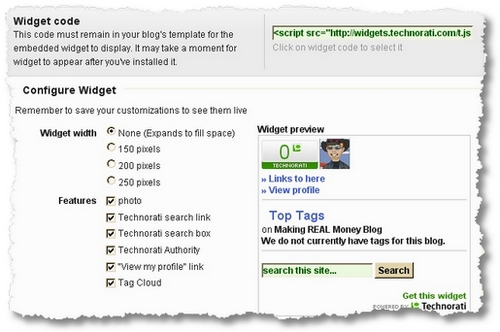
3. However, the ‘Ping Setting’ can be quite useful. Of course, if you are using WordPress, you can simply ping the server automatically when you post by entering the code in the Options >>> Writing Page under ‘Update Services’ and the code is: http://rpc.technorati.com/rpc/ping. Sometimes, though, if Technorati isn’t working properly, you will HAVE to manually ping, and this Ping Setting can be done from your account in Technorati.
Reality Sets In: It’s in the millions!
Once you’ve entered all the settings, you’ll see the somewhat depressing result as one of my blogs below: “No authority” and a rank in the multi-millions! Don’t worry. Once you get a link or two, it quickly zips up as many millions of blogs are registered, but fewer have any referring links at all. Rank: 8,911,336 is pretty much bottom of the pile at the moment!
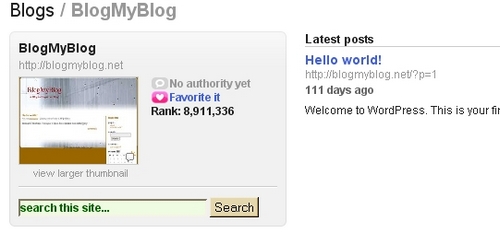
While it’s difficult to give an absolute answer, right now you need about 450 actual links to get your blog within the 10K ranking on Technorati. This blog (InvestorBlogger) has shot up from the multi-million ranking to approximately 39K at the moment. So, encouraging linking, posting links and getting links in posts from friends, bloggers, et al., will help you to zip up to under 100K quickly enough.
You can also gain links through: link trains, memes, commenting on dofollow blogs, guest postings, blog carnivals, directories (sometimes), and entries in all blogs. However, Technorati does not treat all links the same, so not all links will see your ranking rise. For example, blogroll links are seen as poorer quality.
Additional Notes:
Late last year, though, Technorati temporarily discontinued Rankings in favor of “Authority”, for reasons that seem to be unclear, even now. They obviously prefer the term “Authority” but in practice I see little reason for it to exist, or little difference from Ranking, except that it is accumulated from 0. However, this is their rationale:
And finally
So, if you are interested in developing your blog, you will find it worthwhile to register with Technorati as a way to increase traffic (albeit incrementally), exposure (always a good thing), and authority. There’s little to be lost by not registering. So what are you waiting for?



